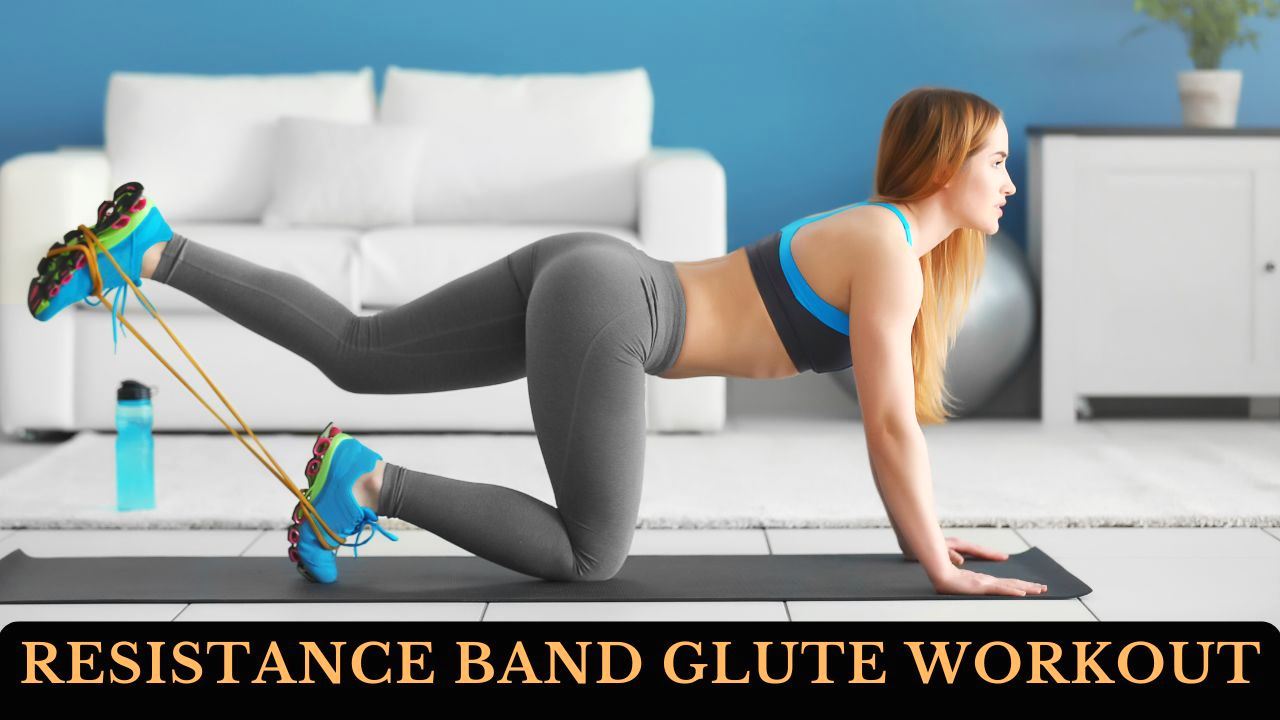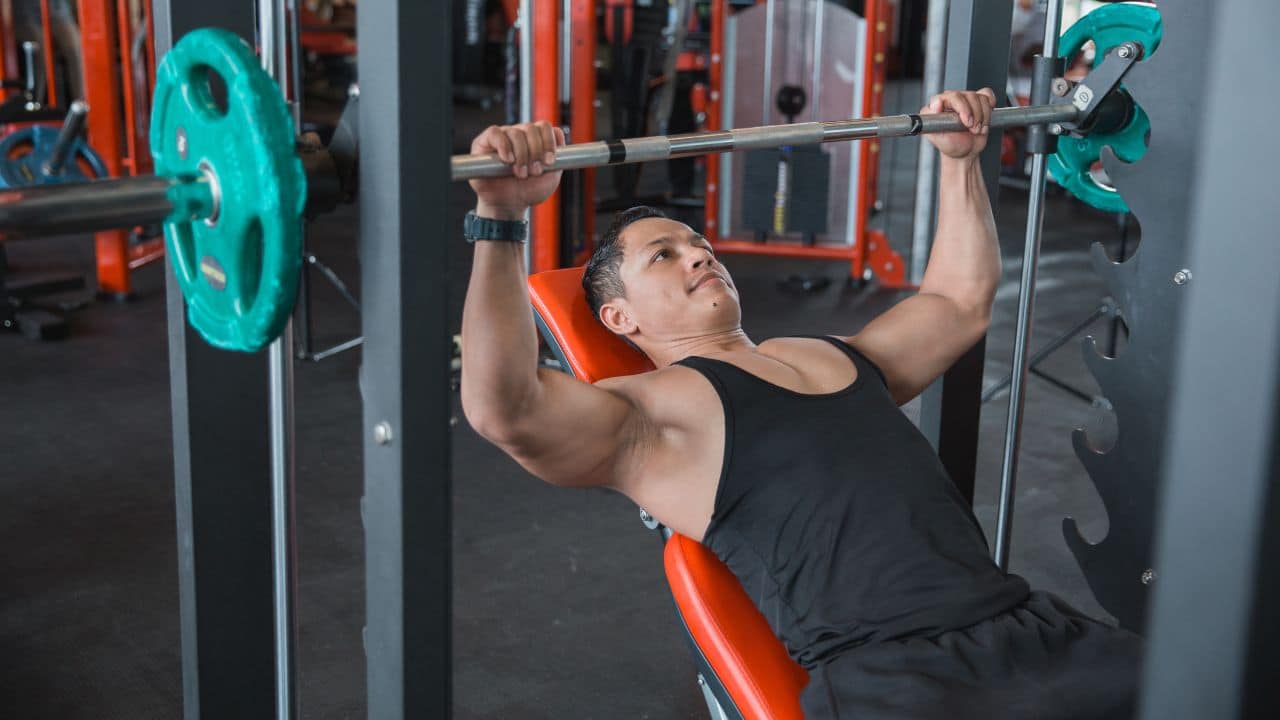Want to build stronger glutes without spending hundreds on gym equipment?
Here is good NEW
Research shows resistance bands can activate your glutes as effectively as traditional weight lifting exercises. And the best part? You can do it all from home with just a $15 piece of equipment.
But here’s the problem:
Most resistance band workouts you’ll find online are either too basic (think endless fire hydrants) or completely miss the science behind optimal glute activation.
That’s why I spent 47 hours analyzing the top peer-reviewed studies on glute training, discussing certified strength coaches, and testing dozens of band exercises myself to create this definitive guide.
Today, I will show you the best workout plans (exercises) to build stronger, more defined glutes using nothing but resistance bands.
Let’s dive in.
How to Design Effective Resistance Band Glute Workouts
1. Understand Your Glute Muscles
First off, let’s get familiar with the gluteal muscle group. Your glutes consist of three main muscles:
- Gluteus Maximus: The powerhouse responsible for hip extension and the most prominent part of your butt.
- Gluteus Medius: Crucial for hip stability and abduction (moving your leg away from your body).
- Gluteus Minimus: Works alongside the medius to help stabilize your pelvis.
2. Fundamental OF Glute training
Before doing exercises, you need to know this important thing:
Your glutes have three primary functions:
- Hip extension (moving your leg backwards)
- Hip abduction (moving your leg outward)
- External rotation (rotating your thigh outward)
3. Choose the Right Resistance Bands
When it comes to resistance bands, one size does not fit all. Here’s what you need to know:
- Different Resistances: Bands come in various thicknesses, so choose a level that challenges you without compromising form. Light bands are great for beginners, while heavier bands are ideal for seasoned pros.
- Loop Bands vs. Tube Bands: Loop bands are excellent for lower-body exercises, while tube bands with handles are versatile for upper and lower-body workouts.
4. Add Both Compound and Isolation Exercises
To design a balanced glute workout, blend compound and isolation exercises.
- Compound Exercises: These engage multiple muscle groups and build overall strength. Like Banded Squats and Banded Deadlifts.
- Isolation Exercises: These focus specifically on the glutes i.e Banded hip thrusts and Banded Donkey Kicks
Beginner Resistance Band Glute Workout Plan
| Exercise | Sets | Reps | Rest |
|---|---|---|---|
| Banded Glute Bridges | 3 | 12-15 | 30-60 sec |
| Banded Squats | 3 | 10-12 | 30-60 sec |
| Lateral Band Walks | 3 | 10 | 30-60 sec |
| Banded Donkey Kicks | 3 | 10-12 | 30-60 sec |
Intermediate Resistance Band Glute Workout
| Exercise | Sets | Reps | Rest |
|---|---|---|---|
| Banded Hip Thrusts | 4 | 12-15 | 30-60 seconds |
| Banded Squats with Pulse | 3 | 10-12 | 30-60 seconds |
| Single-Leg Banded Deadlifts | 3 | 10-12 | 30-60 seconds |
| Banded Fire Hydrants | 3 | 10-12 | 30-60 seconds |
| Banded Side-Lying Leg Raises | 3 | 12-15 | 30-60 seconds |
Mini Resistance Band Glute Workout
| Exercise | Sets | Reps | Rest |
|---|---|---|---|
| Banded Glute Bridges | 3-4 | 12-15 | 30 sec |
| Lateral Band Walks | 3-4 | 10 steps each direction | 30 sec |
| Banded Donkey Kicks | 3-4 | 10-12 per leg | 30 sec |
| Banded Clamshells | 3-4 | 12-15 per side | 30 sec |
Best Resistance Band Glute Exercises For Toned Butts
1. Resistance Band Squat
The resistance band squat is a functional exercise that works the quadriceps, hamstrings, glutes, and core.
Resistance bands add additional load and resistance to regular squats, which allows for greater muscle activation.
Unlike barbell squats that crush your spine with hundreds of pounds, bands provide what I call intelligent resistance.
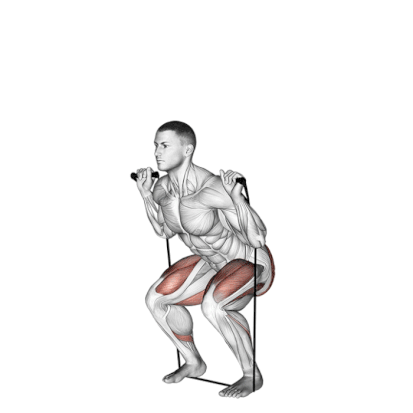
2. Standing Band Donkey Kick
With the Band Donkey Kick, you’re hitting the gluteus maximus directly. When you kick back against resistance, you will feel the burn, knowing that your glutes are working hard from start to finish.
Donkey kicks target the glutes in a way many other exercises can’t. This move can be completed without equipment and modified for all fitness levels.
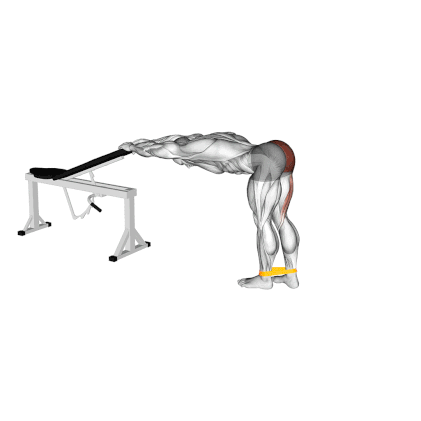
3. Band Clamshell
The band clamshell is a simple exercise, but don’t let it fool you. It delivers major benefits for hip strength and glute activation (isolates the gluteus medius).
Physical therapists might recommend the clamshell exercise for lower-body injury prevention or rehabilitation. It can be helpful for people with knee pain, hip bursitis, or hip impingement.
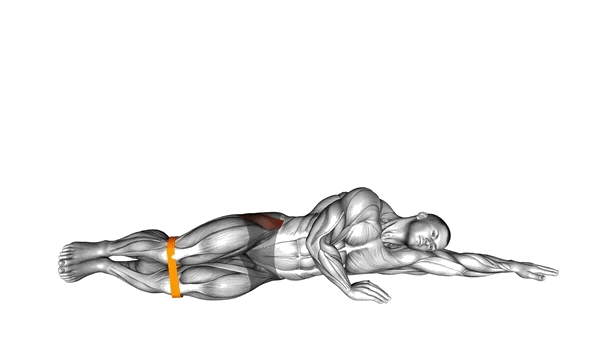
4. Standing Band Hip Abduction
As you perform the standing band hip abduction, you’ll specifically target your hip abductors, including the gluteus medius and tensor fascia lata.
It’s perfect as a warm-up to activate your glutes before bigger lifts or as a finisher to add extra burn. This versatility helps you tailor it to any workout plan.
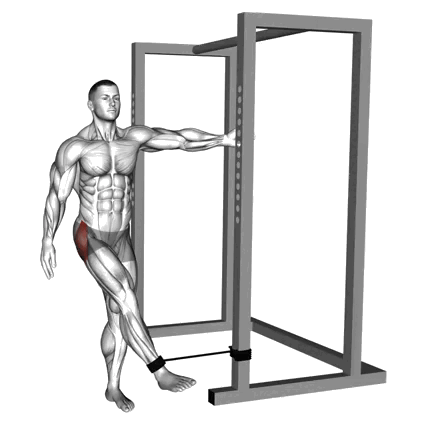
5. Band Fire Hydrants
The band fire hydrant is a glute-focused exercise that simulates the action of a dog at a fire hydrant. It specifically targets the gluteus medius, minimus, and hip abductors.
When done regularly, fire hydrants can sculpt your glutes, improve back pain, and lower the risk for injury.
When you lift your leg, your core works hard to keep your body balanced. This added core engagement builds stability and helps protect your lower back.
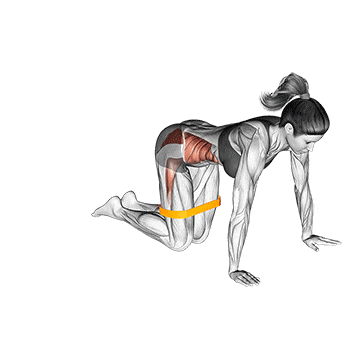
6. Banded Pull-Throughs
You’ve seen someone doing this at the gym and thought “That looks weird.” I get it. But this exercise is actually a goldmine for building a stronger, more aesthetic lower body.
Here’s what makes it special: Full posterior chain activation:
- Glutes
- Hamstrings
- Hip flexors
- They also help your core muscles, hip flexors, obliques, and abs.
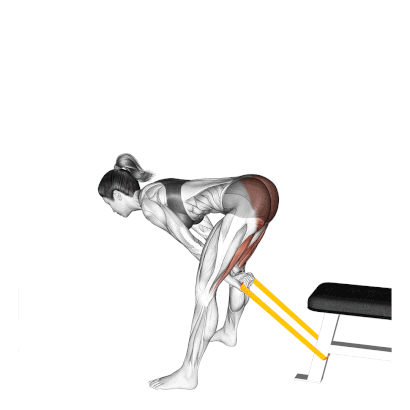
7. Band Side-Lying Leg Lift
The band side-lying leg lift is a good way to do the classic side leg raise, but with a resistance band. This modification increases the challenge and intensifies the workout for your glutes.
It is a great move to target the gluteus medius and minimus (smaller glute muscles on the outer hip).
When you lie down, your joints don’t hurt, so it’s a good choice for low-impact glute exercises. It is also a great option to strengthen your glutes without adding stress to your knees or back.
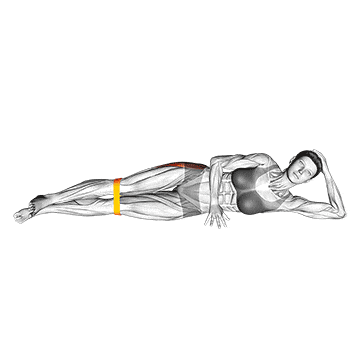
8. Kneeling Hip Thrust
The kneeling hip thrust with a resistance band may look different from the classic prone hip thrust, but the biomechanics are almost the same, especially the activation of the glutes.
As you perform this, you’ll feel your glutes engage like never before. This exercise specifically targets the gluteus Maximus.
You’ll also notice improved hip mobility over time. I’ve seen this firsthand – the controlled movement pattern helps loosen up those tight hip flexors we all get from sitting too much.
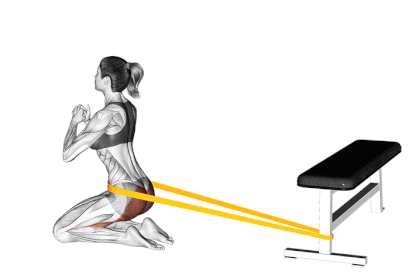
9. Lateral Band Walks
Lateral band walks are an exercise performed with a resistance band around your legs, typically around the ankles or just above the knees.
When you walk sideways, the band provides resistance that targets the hip abductors, particularly the gluteus medius.
Key benefits include:
- Strengthens hip abductor muscles
- Improves hip stability
- Enhances lateral movement ability
- Helps prevent knee valgus (knees caving inward)
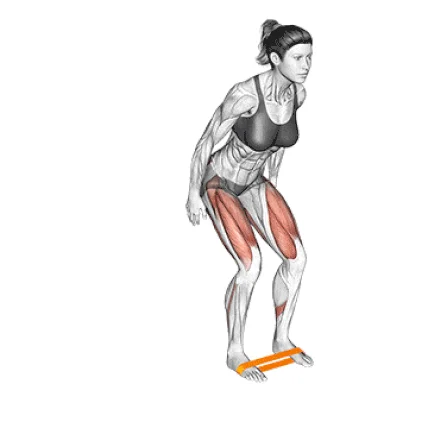
10. Resistance Band Glute Bridge
The resistance band glute bridge is a highly effective lower body exercise for toning the glutes and hamstrings. It also strengthens the ankles and knees.
The band creates constant tension as you drive through your heels and squeeze those glutes at the movement’s top. That means your glutes have to work overtime to maintain control and keep your hips thrust high.
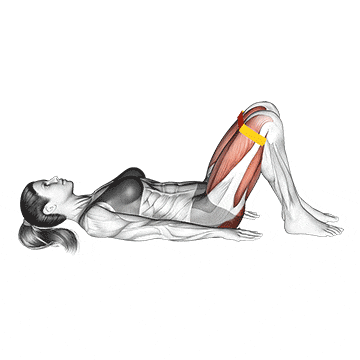
11. Banded Glute Kickbacks
Most people think hip thrusts are the only way to serious glute gains. But here’s something crazy: EMG studies show glute kickbacks can activate your gluteus maximus up to 106% of your maximum voluntary contraction.
Unlike other exercises where tension peaks at one point, kickbacks maintain band tension throughout the entire range of motion.
The tension increases as you extend your leg (exactly when your glutes need to work hardest).
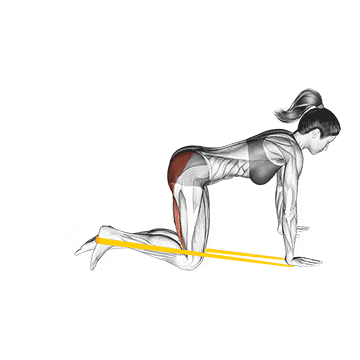
12. Banded Standing Glute Kickback
The standing position + band resistance creates maximal tension exactly when your glute reaches full contraction.
Standing allows for a more extensive range of motion in the glute kickback. This extended motion fully activates the glutes at the peak of the movement.
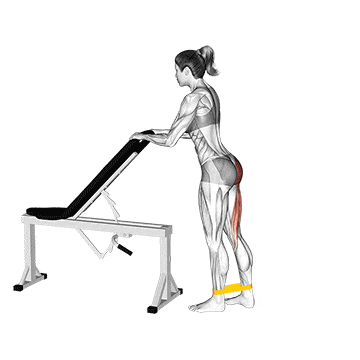
Takeaways
This guide isn’t just another workout plan. It’s your blueprint for building stronger glutes without a gym membership. I’ve tested these band workouts with clients, and they work – if you follow the science.
Here’s What You’ll Get:
- A proven system to progress from beginner to advanced
- Real techniques pros use (not the Instagram fluff)
- Methods that work even if you’re busy (15-30 mins/day)
Why This Works: The secret isn’t the bands – it’s progressive overload and proper activation. Most people skip both. Don’t be most people.
Next Steps: This isn’t rocket science, but it does require consistency. Start small, track progress, adjust as needed. That’s it.
Want to learn more out about band training or share results? Leave a comment below—I read every one.
References
- Neto WK, Soares EG, Vieira TL, Aguiar R, Chola TA, Sampaio VL, Gama EF. Gluteus Maximus Activation during Common Strength and Hypertrophy Exercises: A Systematic Review. J Sports Sci Med. 2020 Feb 24;19(1):195-203. PMID: 32132843; PMCID: PMC7039033.
- Andersen V., Fimland M. S., Mo D. A., Iversen V.M., Vederhus T., Rockland Hellebø L.R., Nordaune K.I., Saeterbakken A.H. (2018) Electromyographic Comparison of Barbell Deadlift, Hex Bar Deadlift, and Hip Thrust Exercises: A Cross-Over Study. Journal of Strength and Conditioning Research 32(3), 587-593.
- Noffal, Guillermo & Pamukoff, Derek. (2018). Biomechanics of resistance training. 10.4324/9781315438450-6.
- Iversen VM, Vasseljen O, Mork PJ, Gismervik S, Bertheussen GF, Salvesen Ø, Fimland MS. Resistance band training or general exercise in multidisciplinary rehabilitation of low back pain? A randomized trial. Scand J Med Sci Sports. 2018 Sep;28(9):2074-2083. doi: 10.1111/sms.13091. Epub 2018 Apr 24. PMID: 29603805.
- Macadam P., Cronin J., Contreras B. (2015). An examination of the gluteal muscle activity associated with dynamic hip abduction and hip external rotation exercise: A systematic review. International Journal of Sports Physical Therapy 10(5), 573.
- Youdas J.W., Adams K.E., Bertucci J.E., Brooks K.J., Nelson M.M., Hollman J.H. (2014) Muscle activation levels of the gluteus maximus and medius during standing hip-joint-strengthening exercises using elastic-tubing resistance. Journal of Sports Rehabilitation. 23(1), 1-11
- Bishop B.N., Greenstein J., Etnoyer-Slaski J.L., Sterling H., Topp R. (2018). Electromyographic analysis of gluteus maximus, gluteus medius, and tensor fascia latae during therapeutic exercises with and without elastic resistance. International Journal of Sports Physical Therapy 13(4), 668-675.
- Nadell, R.S. (2013). The effects of different warm-up modalities on gluteus medius activation.
